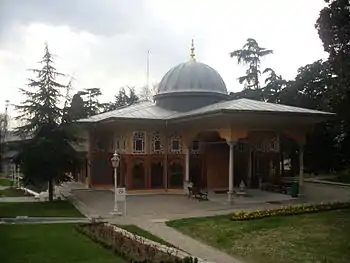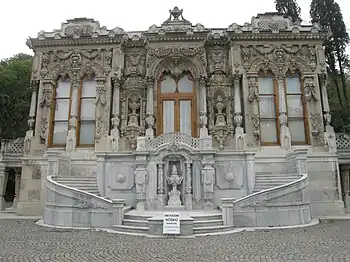Ottoman palaces in Istanbul
This is a list of palaces commissioned by the Ottoman dynasty in İstanbul, Turkey. Some of these buildings are summer houses or mansions.
| Image | Name | Meaning of the name | Construction dates | Commissioned by | Notes |
|---|---|---|---|---|---|
 |
Topkapı Palace Cannon Gate Palace |
Mehmed II called the palace Sarây-ý Cedîd (New Palace). The palace received its current name during Mahmud I's reign when the seaside palace, the Cannon Gate Palace by the Sea (Topkapusu Sâhil Sarâyý) was destroyed in a fire, and its name was changed to the New Palace.[1] | 1460-1478[2] | Mehmet II |
|
 |
Aynalıkavak Palace [n 1] |
The palace is also called Tersane Palace (Shipyard palace) though it has been referred to as “Aynalikavak Palace” since the 17th century.[3] | 1613-1614[4] | Ahmed I |
|
 |
Yıldız Palace Star Palace |
The name Yıldız comes from the Turkish word meaning "star". | The end of the 18th century[5] | Selim III.[n 2] |
|
 |
Dolmabahçe Palace Filled Garden Palace[6] |
The name Dolmabahçe comes from the Turkish dolma meaning "filled" and from the Persian bahçe meaning "garden." | 1843-1856[7] | Abdülmecid I |
|
 |
Ihlamur Palace [n 3] Tilia Palace |
The name Ihlamur comes from Greek and means "tilia".[8] | 1849-1855[9] | Abdülmecid I |
|
 |
Küçüksu Palace [n 4] Small Water Palace |
The name Küçüksu comes from the Turkish küçük meaning "small" and su meaning "water". | 1856-1857[11] | Abdülmecid I |
|
 |
Beylerbeyi Palace Lord of Lords Palace |
The name Beylerbeyi comes from the Turkish beylerbey meaning "Lord of Lords". | 1863-1865[13] | Abdülaziz |
|
 |
Çırağan Palace Torch Palace |
The name Çırağan comes from the Persian čerâğ meaning torch. The area in which the Palace is located was called Çırağan because of the famous Ottoman parties which were held in tulip gardens with torches.[14] | 1863-1871[15] | Abdülaziz |
|
Footnotes
- After the conquest of Constantinople, Sultan Mehmed II (r. 144446, 145181) had a palace built in what is modern-day Istanbuls Beyazýt district, on the spot where the University of Istanbul stands today; this first palace subsequently became known as the Old Palace (Eski Saray). Following the construction of the Old Palace, Mehmed II then had the Tiled Kiosk (Çinili Köþk) built, followed by Topkapý Palace itself, to which the court relocated when construction was complete. Mehmed called this place the New Palace (Sarây-ý Cedîd). The palace received its current name when Sultan Mahmud I (r. 173054) had a large wooden palace constructed near the citys Byzantine walls, in front of which were placed several ceremonial cannons; this seaside palace was named the Cannon Gate Palace by the Sea (Topkapusu Sâhil Sarâyý), and, when this palace was destroyed in a fire, its name was transferred to Mehmed IIs New Palace. Topkapı Palace Museum Archived 2013-11-08 at the Wayback Machine
- Initially constructed between 1460 and 1478 by Sultan Mehmed II, the conqueror of Constantinople, and expanded upon and altered many times throughout its long history, the palace served as the home of the Ottoman sultans and their court until the middle of the 19th century. Topkapı Palace Museum Archived 2013-11-08 at the Wayback Machine
- "AYNALIKAVAK PAVILION" Archived 2016-01-28 at the Wayback Machine National Palaces Archived 2013-11-09 at the Wayback Machine. Retrieved 18 August 2014
- "İslâm Ansiklopedisi Online (in Turkish)" PDF "TDV Encyclopedia of Islam". Retrieved 18 August 2014
- XVIII. yüzyıl sonunda, Sultan III. Selim (1789-1087) validesi Mihrişah Sultan için buraya başka bir kasır yaptırmış ve bu kasra "Yıldız" ismi verilmiştir. Translation. In the end of the 18th century, Sultan Selim III (1789-1807) built another pavilion here for his mother, Mihrişah and the pavilion was named "Yıldız". www.kulturvarliklari.gov.tr
- Dolmabahçe Means Filled Garden Istanbul Trails
- Dolmabahçe Palace was built by Sultan Abdulmecid (1839-1861) who was the thirty first Ottoman Sultan. The palace, whose construction commenced on June 13th, 1843, was brought into use on June 7th, 1856, upon completion of surrounding walls. National Palaces Archived 2017-05-04 at the Wayback Machine
- "IHLAMUR" Turkish Language Association. Retrieved 18 August 2014
- "IHLAMUR PAVILIONS" Archived 2016-02-08 at the Wayback Machine National Palaces Archived 2013-11-09 at the Wayback Machine. Retrieved 18 August 2014
- "İslâm Ansiklopedisi Online (in Turkish)" PDF "TDV Encyclopedia of Islam". Retrieved 18 August 2014
- The pavilion which was also used during the period of Sultan Mahmud II (1808-1839) was demolished by the order of Sultan Abdülmecid (1839-1861) and Küçüksu Pavilion was built there between the years 1856-1857. National Palaces Archived 2017-07-06 at the Wayback Machine
- Küçüksu Pavilion was designed by Nikoğos Balyan and completed in 1857. Ministry of Culture and Tourism of the Republic of Turkey
- it was constructed on demand of the sultan of the period, Sultan Abdülaziz (1861 - 1876). Construction of the palace was commenced on 6 August 1863 and it was formally opened to usage on 21 April 1865, Friday. National Palaces Archived 2011-11-11 at the Wayback Machine
- Palaces of Istanbul
- "İslâm Ansiklopedisi Online (in Turkish)" PDF "TDV Encyclopedia of Islam". Retrieved 18 August 2014
Notes
- The palace is also known as Aynalıkavak Pavilion
- Sultan Selim III built the palace for his mother, Mihrişah
- The palace also known as Ihlamur Pavilion
- The palace also known as Küçüksu Pavilion or Göksu Pavilion
This article is issued from Wikipedia. The text is licensed under Creative Commons - Attribution - Sharealike. Additional terms may apply for the media files.